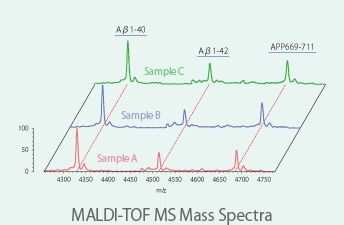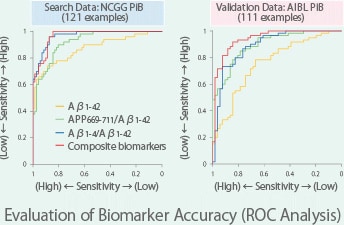Alzheimer's Drug Discovery Support
The beta-amyloid deposition level in the brain, which gradually changes as Alzheimer's disease progresses, is used
as an indicator for determining and monitoring how far the disease has progressed. Currently, PET imaging scans and
cerebrospinal fluid examinations are the only two methods currently available for detecting beta-amyloid levels. However, PET
scans are expensive and only available from a limited number of facilities, whereas acquiring cerebrospinal fluid is a highly invasive
procedure. Therefore, in response to a growing need for a low-cost and easy examination method, we developed a method that can be
used to screen a larger number of people based on blood tests. In 2014, Shimadzu Corporation and the National Center
for Geriatrics and Gerontology discovered a peptide ratio that is effective as a blood biomarker for detecting Alzheimer's lesions
by IP-MS. Furthermore, a composite biomarker was developed by combining that biomarker with another peptide ratio.
- Blood Biomarker for Alzheimer's Beta-Amyloid Deposit
- Mass spectrometry was used to successfully discover 22 biomarkers, including 8 newly discovered biomarkers. During that process, we also discovered that the ratio between two biomarkers, Aβ1-42 and APP669-711, correlates to the progression of Alzheimer's disease.
Mechanism of IP-MS Method
IP-MS combines immunoprecipitation (IP), which achieves selective separation based on an antigen-antibody
reaction, with mass spectrometry (MS). In this case, an anti-beta amyloid monoclonal antibody
was used to extract beta-amyloids from blood plasma, with the beta-amyloids measured using a matrix-assisted
laser desorption/ionization time-of-flight mass spectrometer (MALDI-TOF MS).
-
(1)React the magnetic beads bound to anti-beta amyloid antibodies
with the blood plasma sample. -

(2)Elute the beta-amyloid in the blood plasma from the magnetic beads.
-

(3)Analyze the eluate solution in the MALDI-TOF MS system.
-
・MALDI-TOF MS for Estimating the Beta-Amyloid Deposition Level in the Brain
This system enables many types of beta-amyloids to be characterized and simultaneously detected with high sensitivity by analyzing only 0.6 mL of blood plasma. Of these beta-amyloids, Aβ1-42, Aβ1-40, and APP669-711 can be used in combination as biomarkers to estimate the deposition level with high accuracy.


-
※Note: Offered as contract analysis service (only in Japan).
FOR RESEARCH USE ONLY. NOT FOR USE IN DIAGNOSTIC PROCEDURES.
The results of this research were published in Nature volume 554, pages 249 to 254 (2018)
"High performance plasma amyloid-β biomarkers for Alzheimer's disease" (doi:10.1038/nature25456).
Collaborative Research Partner
“For more than 30 years, academics have been looking for a test that has high performance in predicting the development of Alzheimer's disease. This is one of the great unmet needs of our society. If a test that only requires taking a few drops of blood with just a minimal invasion really performs well, it will allow the early detection of Alzheimer's disease and assist in developing new therapeutics. SHIMADZU has a long history and a reputation of doing excellent work in developing high performance analytical technology. I'm very confident that this partnership between Industry and Academia is the only way that we can make real progress in this field.”



